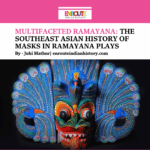How Samudralanghna was the biggest taboo in Indian Culture.
Traveling is often described as an adventurous voyage, one which is filled with experiences of a lifetime but like any other practice, it is also not devoid of Taboos and Superstitions. The sea voyage or crossing the ocean described as ‘Samudrolanghana’ is one such form of travel that not only entails but is in itself described as a form of taboo for many Hindus. The Dharmasutra of Baudhayana describes undertaking a sea voyage as a sin that would lead to the loss of caste. The declaration of such a percept is also followed by the process through which one can amend this wrongdoing. The Dharamsutra states remorse and how it should be followed to wipe off sins. This includes eating little at every fourth meal of the day and bathing three times at dawn, noon, and dusk. The Dharamsutra further states that the person performing remorse must keep standing throughout the day and seated at night, doing so would eventually wipe off the taboo of trespassing the sea.
 (Source: This Day In Indian History; An artist representation of the Kala Pani Taboo)
(Source: This Day In Indian History; An artist representation of the Kala Pani Taboo)
The idea prevalent among Hindus was that as soon as one traveled across the sea, they drove themselves away from the holy water of the Ganges to the Land of Barbaric or mlecchas as the outsiders were typically referred to. Hereby, leading to physical and spiritual disassociation from their land. The water of the Ganges was deemed to be regenerative and necessary for rebirth. Once someone traveled away from this pure water into the land of a foreign language, they were believed to have lost their caste and religion. While in most cases, the Dharmasutra precepts were not so rigidly obeyed in India. They, however, would have acquired a space in the subconscious of people, who were at threat of being ostracized for committing such Taboo and hence this bewilderment related to travel across the sea came to be frequently referred to as the Kala Pani trope.
The most famous story indicating the widespread taboo of crossing Kala Pani is perhaps of Maharaja Sawai Madho Singh II of Jaipur, etched in time as the Maharaja who took Gangajal to London. Maharaja Sawai Madho Singh II was a devout Hindu and was invited to London in 1902 for King Edward VII’s coronation. The invite found the Maharaja lingering in a dilemma as he could not flout the invitation but at the same, traveling to London meant crossing Kala Pani which would put his religiosity in question. The priests in his court advised him of a detailed discourse that he had to follow during his two-month-long travel overseas. This involved the use of Gangajal as the only source of water. As advised, Maharaja Sawai Madho Singh II carried with him Gangajal in three large Silver Urns each measuring around 1.6 m in height and 2.48 m in circumference, having a capacity to contain approximately 1800 liters of Gangajal. On his journey, one of the Silver Urn was dumped into the sea but the remaining two were used by the king during his entire travel journey to keep himself religiously chaste. Presently, both the Silver Urns are out on display in the Sawai Man Singh City Palace Museum, Jaipur, and hold the Guinness World record for being the Largest single piece of Silverware.


( Source: The Hindu; Fig 1: Silver Urn in which Gangajal was carried to London. Fig2 : Maharaja Sawai Madho Singh II Of Jaipur)
COLONISTS AND THE KALA PANI TROPE
This hesitation and underlying fear of traveling across the sea was triggered and reignited by the coming of the British Colonials. Scholarly works such as those of S.Sen titled, ‘Disciplining Punishment: Colonialism and Convict Society in the Andaman Islands’ (2000) imply that the trope of Kala Pani and the taboo encircling it was at times overemphasized by the Orientalists. The reiteration of this taboo on the colonist’s part was met to create strong imagery of overseas Transportation as a punishment. A punishment that would be feared as much as capital punishment as it implied social exclusion. In 1838, the Committee on Prison Discipline described transportation as an “Indescribable horror”. Several of the British policies and practices involved Indians boarding ships. While sometimes such overseas travel was voluntary, in other cases it involved deportation and deployment by the Britishers. The Kala Pani theme frequently features in the accounts of the Indentured laborers who were immigrants to the so-called ‘promised lands’. Most of these migrants were from north India and were immigrants to Fiji, Mauritius, Trinidad and Tobago, and Martinique sugar plantations. British officer’s accounts reveal that the indentured laborers were informed that they were going to ‘Tapu’ and the word ‘Kala Pani’ was deliberately avoided.
Travel across Kala Pani meant different things for different people, who came from diverse strata of society. For the upper strata, it signified the threat of losing their caste as they were not only beyond sea but also sharing a ship with so-called ‘lower castes’. Another point of the debate argues that once aboard, the caste status of the immigrant by committing a taboo took a backseat and the solidarity developed among the shipmates as ‘Jahaji Bhai’. The Dalits and Women however expected the unknown tapu as a land of opportunities but these expectations weren’t always met. Especially for women who were driven away from their family, and were vulnerable to the scathing at the hands of men. The plight of women in these foreign lands is profoundly articulated in Premchand’s story titled ‘Shudra’, where the protagonist Gaura and her husband were trapped and falsely deported to a foreign lands. Their lives became so insufferable in those plantations that both of them ended up committing suicide. As a profound writer, Premchand’s story depicts how the taboo of Kala pani was also accompanied by the fear of torturous treatment at the hands of the British.

(Source: The Indian Express; The Britishers documented the arrival and deportation of the Indian immigrants)
The fear of Samudrolanghana was not restrained to the general populace alone but the sepoys serving in the British army too became a victim of this taboo. The year 1856 in India saw the coming of Lord Canning and with him the assent to the Act that acted as the final catalyst for the Indian sepoys to lose confidence in the British Raj. The General Service Enlistment Act was enacted on 25th July 1856 which required the newly recruited troops to serve overseas if required. Such an act threatened the religious sentiments of the already employed high-caste Hindu sepoys and according to Phillip Mason (1986) served as the basis for the rumors that spread over the next twelve months. The General Service Enlistment Act threatened the underlying fear of traveling across Kala Pani, fuelled religious sentiments in an already suspicious atmosphere against the British, and served as the motivating factor for the sepoy mutiny in 1857.
The 1857 uprising gave way to the British establishing a penal colony in the Andamans, which over time came to be a place equated with the Kala Pani metaphor. It became the Indian ‘Devil’s Island’ after the British took an interest in it in the late 18th c. The Andamans entered the popular Indian awareness and imagination as ‘Kala Pani’ only after the prison colony was established there in 1858. The Cellular jail built in 1906 in the Andamans came to be associated with the trope of ‘Kala Pani ki Saza’ because of the isolation and ruthless harsh treatment given to the inmates.

(Source: The Hindu; Cellular Jail infamously known as ‘Kala Pani’ today stands as a national memorial in respect of our late national heroes)
The British thought that disposing of the political prisoners to the isolated island across the sea would make their reacceptance in society a distant dream. However, in the wake of the national movement the taboo subsided and the prison became a pilgrimage for many Indian national leaders. The most prominent among them is V.D Savarkar, who was transported there for his part in the Nasik Conspiracy case at the end of 1910. His work in Marathi titled ‘Majhi Janmathep’ translated in Hindi as ‘Kala Pani’ is an account of his term as an inmate in the cellular jail. Savarkar wrote how the Britishers would aim to pinch the religious undertones within the prison by deliberately appointing Muslim and low-convict murderers to oversee ‘high caste’ Hindu inmates. The echo of these atrocities which our national leaders suffered traveled to the mainland and Andamans, as well as the prison sentence etched in People’s minds as the ‘Kala Pani’ trope. The word Kala pani became a symbol of oppression and got reflected in popular culture as a metaphor for prison such as in the case of Dev Anand’s produced 1958 movie titled ‘Kala Pani’

(Source: IMDB; Poster of Dev Anand’s movie Kala Pani. The movie provides us an understanding of how people understood the Kala Pani trope.)
The taboo related to Samudralanghana was also readdressed recently in modern popular culture by the Popular Netflix Anthology series ‘Stories by Rabindranath Tagore’(2015). Episode 15 of the television series titled ‘Tyaag’ is based on Tagore’s work titled ‘Renunciation’. It displays the revenge of a Bengali man whose son-in-law was ostracized and excommunicated from their caste, religion, and society for traveling overseas to London. The story brings forth the idea of purity and pollution and how it shaped the existence of many families in Traditional Orthodox society. The trope of Kala Pani has evolved itself as a theme in history, one which has been associated with taboo, Indian migrants, and finally the national movement. As we sit in this ‘Globalized’ world, having the largest diaspora where traveling abroad is considered an opportunity and a dream for many, it is almost impossible to fathom the fact that once this travel across sea weighed on the shoulders of our forefathers as a taboo.

(Source: The Film Sufi; Scene from the episode ‘Tyaag’ of the Netflix series ‘Stories by Rabindranath Tagore’)
REFERENCES
Largest pieces of silverware [Online]. Guinness World Records. Available at: https://www.guinnessworldrecords.com/world-records/67131-largest-pieces-of-silverware (Accessed: 15 July 2023).
- Mason, (1986). A Matter Of Honour : An account of the Indian Army, its officers and men. 1st ed. London: Macmillan.
- Strange, and A. Bashford, (2003). Isolation: Places and Practices of Exclusion. 1st ed. London and New York: Routledge Taylor & Francis Group.
Bannerjee, Rohini (2010) “The Kala Pani Connection: Francophone Migration Narratives in the Caribbean Writing of Raphaël Confiant and the Mauritian Writing of Ananda Devi,” Anthurium: A Caribbean Studies Journal: Vol. 7 : Iss. 1 , Article 5. Available at: http://scholarlyrepository.miami.edu/anthurium/vol7/iss1/5
- Bates, and M. Carter, (2021) ‘Kala pani revisited: Indian labor migrants and the sea crossing’, Journal of Indentureship and Its Legacies, 1(1st ed.), pp. 36-62. Available at: https://www.jstor.org/stable/10.13169/jofstudindentleg.1.1.0036
- Gupta, (2014) ‘Saving ‘WRONGED’ Bodies: Caste, Indentured Women And Hindi Print-Public Sphere In Colonial India’, Proceedings of the Indian History Congress, 75pp. 716-722. Available at: https://www.jstor.org/stable/44158452



















